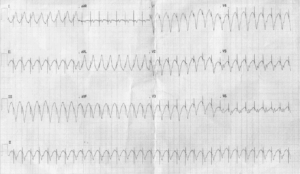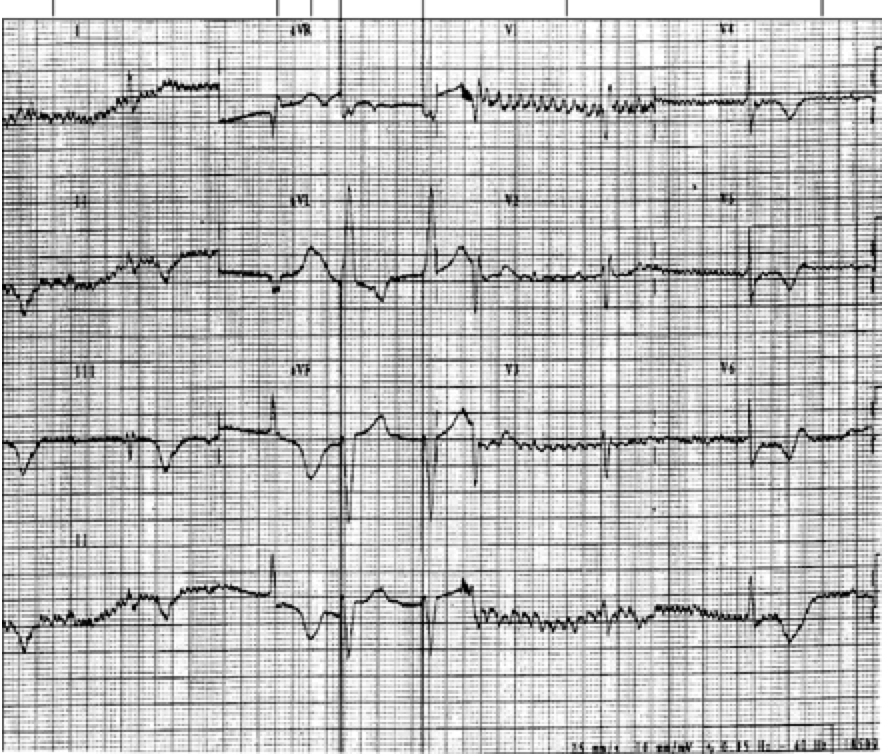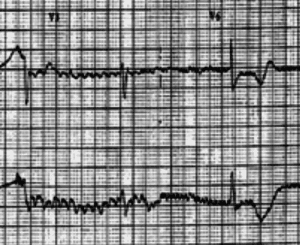A potential complication of a failing pacemaker, is a condition known as ‘Runaway Pacemaker’. Below are two cases from the literature, that demonstrate a runaway pacemaker causing a potentially lethal ventricular arrhythmia.
Whenever we look at an ECG, we always look for the pacing spikes. These may not be visible, especially if the patient’s rate is above that set for the pacemaker. The spikes may sometimes be visible and sometimes not and in these situations we need to work out if the pacemaker is being inhibited, or if it is faulty.
Case 1
An elderly gentleman presents with several days of fluttering in his chest and chest pain. He has a past medical history of complete heart block for which he has had a pacemaker inserted. His ECG is shown below. What does it show?

Source: BMJ Case Rep 2019(1)
This ECG shows ventricular pacing at a rate of at least 150 beats per minute. The arrhythmia did not respond to metoprolol and amiodarone, but was terminated with application of a magnet and the pacemaker replaced. On pacemaker interrogation, the rate had been 189bpm.
This is an example of a ‘runaway pacemaker’.
It is a pacemaker-induced ventricular tachycardia, due electronic failure(2). It can also occur in certain circumstances where ventricular extra-systoles occur, such that they don’t inhibit the pacemaker output, resulting in a ventricular tachycardia, or when a ventricular beat is not sensed by the pacemaker and ventricular pacing is delivered resulting in a ventricular tachycardia.(3)
Case 2
An elderly patient presents following several pre syncopal episodes. He has a history of complete heart block for which he has a pacemaker. His ECG is shown below.

Source: EP Europace, 2005(4)
The ECG shows pacemaker spikes with no ventricular capture and an escape rhythm of about 40bpm.
 There are low amplitude pacemaker spikes at a very high rate, that fail to capture.
There are low amplitude pacemaker spikes at a very high rate, that fail to capture.
These impulses did not change following application of a magnet.
This is another example of a ‘runaway pacemaker’.
It is a malfunction of the pacemaker generator, mostly due to battery failure or external damage.
The very rapid rate doesn’t capture, most likely due to
- the rate being very high and the ventricles being refractory to it and secondly
- the low amplitude of the waveforms.
Summary
We looked at two cases of a runaway pacemaker causing a potential lethal ventricular arrhythmia. Pacemaker malfunction can result in loss of capture of the pacemaker, a failure to pace, or the more serious, ventricular arrhythmias including ventricular fibrillation.
Although new age pacemakers and defibrillators have built in safety measures, this rare phenomenon can still occur.
Fixing the problem may not be straightforward. Application of a magnet may not disengage the pacemaker, or slow the rate, but should be tried. If all else fails, the pacemaker leads may need to be cut. Following this, and depending on the underlying rhythm, the patient may then need to be paced.
References
- Gul A, et al. BMJ Case Rep 2019;12:e225411. doi:10.1136/bcr-2018-225411
- Wisoff BG, Wisoff MD. pacemaker-induced ventricular tachycardia. JAMA 1965;192:258.
- Lefroy DC, Crake t, Davies DW. Ventricular tachycardia: an unusual pacemaker-mediated tachycardia. Br Heart J 1994;71:481–3.
- Ortega DF et al. Runaway Pacemaker: A forgotten phenomenon? EP Europace, Volume 7, Issue 6, 2005, Pages 592–597
Peter Kas










